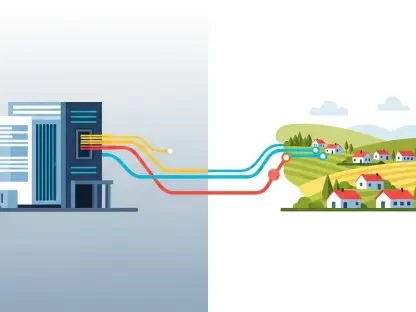In an era where global connectivity defines business success, voice communication remains a vital lifeline for enterprises across industries like banking, healthcare, and retail, enabling urgent and personal interactions that digital alternatives often cannot match. However, as organizations shift from traditional telephone systems to Voice over Internet Protocol (VoIP) and broadband technologies, a critical flaw has emerged in international communications. Cross-border call authentication is failing on a global scale, with legitimate calls frequently being blocked, mislabeled as spam, or distrusted by recipients. This breakdown creates a fragmented trust environment that disrupts operational workflows and erodes customer confidence at a time when real-time engagement is more crucial than ever. The transition to IP-based networks, adopted by nearly a third of businesses for its cost-effectiveness and adaptability, has introduced layers of complexity in call delivery across diverse networks, exposing systemic vulnerabilities that demand urgent attention.
Unraveling the Trust Deficit in Global Telecommunications
The core issue undermining cross-border call authentication lies in the fragmented trust landscape that characterizes global telecommunications today. While frameworks such as STIR/SHAKEN have shown promise in curbing spoofing and fraud within specific regions like the U.S. and Canada, their impact diminishes significantly when calls cross international boundaries. The lack of uniform adoption and interoperability among communication service providers (CSPs) results in many legitimate international calls, particularly those routed through VoIP, receiving low trust ratings—often marked as a “C” attestation in the U.S. system. Such designations frequently lead to calls being flagged as suspicious or blocked entirely, even when they originate from credible sources. This inconsistency not only hampers communication but also reveals a deeper structural flaw in how trust is established and verified across disparate networks, leaving businesses caught in a web of misidentification and unnecessary barriers.
Beyond the technical discrepancies, the trust deficit is worsened by the intricate nature of VoIP traffic, which often travels through multiple networks before reaching its destination. Each hop along this journey introduces potential points of failure where authentication data may be lost or misinterpreted by CSPs lacking direct trust relationships. This complexity is a stark departure from the relatively straightforward routing of traditional phone networks, and it underscores why current systems struggle to keep pace with modern communication demands. As a result, enterprises making international calls face an uphill battle to ensure their communications are recognized as legitimate, with many falling victim to overzealous filtering mechanisms. The absence of a cohesive global standard for verifying call authenticity continues to perpetuate this cycle of distrust, highlighting the pressing need for a more integrated approach to authentication that can bridge the gaps between national systems and foster reliability.
Economic and Operational Impacts on Enterprises
The repercussions of failing cross-border call authentication ripple through global enterprises, causing tangible economic and operational damage. Consider a scenario where a U.S.-based bank, relying on customer support centers in the Philippines, finds its outreach efforts thwarted as calls are tagged with labels like “Spam Likely” on recipients’ phones. Similarly, a European retailer attempting to connect with American clients often encounters skepticism, as consumers hesitate to answer calls from unfamiliar numbers. Research paints a sobering picture: a staggering 92% of individuals perceive unidentified calls as fraudulent, while nearly 80% refuse to pick up such calls altogether. These missed connections translate directly into lost revenue, wasted time for call agents, and diminished trust from customers, particularly in sectors where immediate communication is paramount to maintaining relationships and resolving issues.
The financial toll extends beyond missed opportunities, as businesses must also grapple with the rising costs of navigating this unreliable communication landscape. Enterprises are often forced to invest in alternative outreach methods or additional verification processes to circumvent the barriers posed by blocked or distrusted calls, driving up operational expenses. Furthermore, the erosion of customer confidence can have long-lasting effects, as repeated failures to connect may lead consumers to question the reliability or legitimacy of the calling organization. Industries that depend heavily on voice for high-stakes interactions, such as healthcare providers coordinating urgent care or financial institutions verifying transactions, face especially severe consequences when calls fail to reach their intended recipients. This widespread impact illustrates how the authentication crisis is not merely a technical hurdle but a critical business challenge that threatens the viability of international operations.
Misconceptions Around Authentication Levels
A significant factor contributing to the failure of cross-border call authentication is the oversimplification of attestation levels as indicators of fraud, often leading to unfair treatment of legitimate calls. In the U.S., for instance, international calls terminating in the country are frequently assigned a “C” attestation, signaling a lower level of trust in the caller’s identity. However, this designation does not inherently imply fraudulent intent; it often reflects the complex routing paths of VoIP calls or the absence of direct trust agreements between CSPs across borders. Despite this nuance, many systems and recipients interpret such low attestation levels as a red flag, resulting in calls being filtered out or labeled suspiciously. This blunt approach to call validation inadvertently penalizes honest businesses, lumping them in with malicious actors and undermining their ability to communicate effectively on a global stage.
This misjudgment of authentication levels reveals a critical gap in how current anti-fraud measures are applied, prioritizing caution over precision. The reality is that VoIP technology, while innovative, introduces variables that traditional systems were never designed to handle, such as multi-network traversals that degrade trust signals along the way. As a result, enterprises engaging in cross-border communication bear the brunt of these overly simplistic assessments, facing disruptions that could be avoided with a more sophisticated framework for evaluating call legitimacy. The industry must move beyond blanket assumptions about low attestation scores and develop smarter filtering mechanisms that account for the intricacies of modern call paths. Without such advancements, the collateral damage to legitimate international traffic will persist, further straining the trust ecosystem and hindering the potential of voice as a reliable communication tool for global businesses.
Challenges Posed by the VoIP and Broadband Shift
The widespread adoption of broadband and VoIP technologies has revolutionized business communications, offering unparalleled scalability and cost efficiencies that have made them the default choice for many organizations. However, this shift has also created a double-edged sword, as the flexibility of IP-based systems often becomes a liability in the absence of interoperable authentication standards. Unlike the clear boundaries of traditional Public Switched Telephone Networks (PSTN), VoIP blurs the lines between domestic and international traffic, with calls traversing a maze of networks that lack unified trust protocols. This structural ambiguity heightens the risk of calls being misidentified or blocked, turning a technological advancement into a significant barrier for reliable cross-border communication and threatening the role of voice as a critical channel for high-value engagement.
Moreover, the rapid transition to VoIP and broadband exposes systemic vulnerabilities that current authentication frameworks are ill-equipped to address. As calls move through diverse CSPs with varying levels of compliance with standards like STIR/SHAKEN, the likelihood of trust degradation increases, particularly for international traffic. This inconsistency is compounded by the sheer volume of VoIP usage, with a substantial portion of global enterprises relying on these systems for their day-to-day operations. The resulting chaos in call authentication not only disrupts business continuity but also risks undermining consumer confidence in voice communications as a whole. Addressing this challenge requires a fundamental rethinking of how trust is established in a VoIP-driven world, ensuring that the benefits of modern technology are not overshadowed by the pitfalls of fragmented systems and inadequate safeguards against mislabeling.
Pathways to Restoring Global Call Reliability
Addressing the crisis in cross-border call authentication demands innovative and collaborative solutions tailored to the realities of a VoIP and broadband-dominated landscape. One promising avenue is the development of cross-border call authentication mechanisms, where CSPs exchange verified credentials and metadata over IP networks to validate calls on a global scale. This approach, akin to a worldwide trust handshake, could significantly reduce the incidence of legitimate calls being flagged as suspicious by establishing a clear chain of authenticity across borders. Additionally, international traceback initiatives offer a complementary solution by enhancing visibility into call origins, allowing for greater accountability and the ability to distinguish genuine traffic from fraudulent activity without resorting to indiscriminate blocking practices.
The urgency for such solutions cannot be overstated, as the stakes for CSPs, enterprises, and consumers continue to mount. Beyond technical innovations, achieving reliable global call authentication will require unprecedented cooperation across the telecommunications industry, including regulators and businesses, to create interoperable standards that transcend national boundaries. Drawing from the success of domestic anti-fraud measures like STIR/SHAKEN, the industry has a proven blueprint to build upon, but scaling these efforts internationally presents a unique set of challenges that demand coordinated action. The economic and operational benefits of restoring trust in voice communications are clear, from safeguarding high-margin international traffic for CSPs to ensuring seamless customer engagement for enterprises. As these initiatives gain traction, they hold the potential to transform the fragmented trust environment into a cohesive, dependable system that supports the future of global connectivity.









